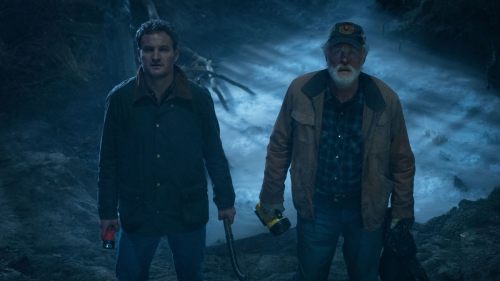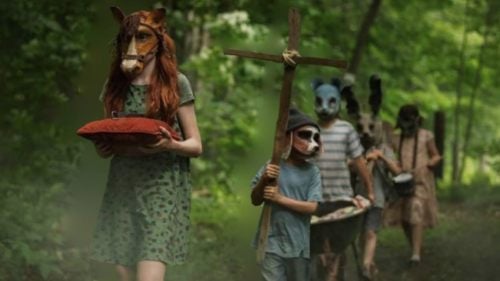SXSW Review: PET SEMATARY Impressively Exhumes Our Deepest Fears
Death is inevitable. While we know this to be a universal truth, it is a subject so painful, so terrifying that many avoid the topic altogether. Author Stephen King adroitly buries this truth deep into the heart of his stories in order to arouse a relatable, emotional weight while utilizing horror as a catharsis in order to deal with circumstances we as humans cannot control or foresee. Starry Eyes director duo Kevin Kölsch and Dennis Widmyer enrich and exhume these humanistic horrors while mostly adhering to the original formula of King’s 1983 novel, Pet Sematary. In their adaptation of the same name, death and grief are ruthlessly personified and the thematic intensity of loss rises from the dead to deliver one of the best King adaptations to date.
Pet Sematary follows the nuclear Creed family as they move to a Ludlow, Maine. Patriarch Louis Creed (Jason Clarke) accepts a new position at the local university hospital and his wife Rachel (Amy Seimetz), son Gage (Hugo Lavoie), daughter Ellie (Jeté Laurence), and cat Church (short for Winston Churchill) join along. Upon exploring their new home and surrounding fifty acres of woodland, they discover a “pet sematary” where the local children bury their beloved critters. They even hold funeral processions complete with creepy animal masks and banging drums reminiscent of the bells used during the Bubonic Plague when people would call for townsfolk to “bring out your dead”. Behind a towering barrier, deeper into the woods, the soil is...sour. As their widower neighbor Jud Crandall (John Lithgow) states, “the pet sematary is where the dead rest, beyond the barrier is where the dead walk.” Victor Pascow (Obssa Ahmed), a student Louis was unable to resuscitate from fatal injury, warns him not to break the barrier. However, grief can be a dangerous monster in and of itself, and the temptation to see your loved ones just one more time eventually overpowers the normally pragmatic doctor. Driven by heartbreak, his nightmare and fate is sealed. Jeff Buhler’s grief-stricken screenplay is horrific and continues to emphasize that “sometimes dead is better.”
If you haven’t seen the trailer for the film and want to go in completely blind, here is where you should stop reading because this latest adaptation is not a remake. Kölsch and Widmyer deviate from the original material at times, but the choices are wise and executed in a manner that drives a stake into the stony soil of a man’s heart with even sharper and deeper precision. For those who have seen the trailer (and film poster), it comes as no surprise that Ellie is the Creed child that “comes back”. In King’s novel, director Mary Lambert’s seminal adaptation in 1989, and in this film, Ellie is wise beyond her nine years and engages in philosophical dialogue about life and death with her logical father who, as a doctor, welcomes an open conversation about the natural process. Ellie (known lovingly and later fearfully by her family as “Ellie the great and terrible”) inquires about what happens after someone dies and wonders why animals don’t live as long as humans, to which Louis always has a reasonable reply. Rachel, on the other hand, avoids the topic and believes Ellie should still be somewhat sheltered from life’s harsh outcome. The choice to bring Ellie back allows for more traumatizing screen time than the original film allowed. Her contemplations on life and death come full circle and the script contains a more philosophical, religious, and moral context that could not have worked if Gage was the one who passed away this time. Ellie personifies grief and guilt in a truly menacing manner, calling to mind all of the pain and regret her parents harness from her death. While many of us internalize these excruciating burdens, Ellie verbalizes them while embodying the pain and decay of a parent’s broken heart. Laurence captures the doe-eyed lovable daughter as well as the diabolic dead with enormous talent. There is also a larger characterization to Rachel which yields an interesting take on the limits of a mother’s love. Seimetz’s performance is gripping, and her spiral through sadness and trauma is purely gut-wrenching.
The imagery and technical application of Pet Sematary perfectly compliments the film’s profound themes of death, grief, and trauma. Even the family name, Creed, is defined as ‘a system of beliefs or aims which guide one’s actions’. It’s as though the Creed family is destined for their dismal outcome, and the way in which this is captured on camera is an impressive work of art. For one, the practical effects are fantastic. The gaping wound on Pascow’s head and slice to Jud’s Achilles tendon are all gruesomely executed in a revolting manner. It truly speaks to the art form and talented special effects crew on this film. However, Kölsch and Widmyer avoided exorbitant amounts of gore in order to focus on the emotional horror - an effective approach since there’s a lot to love about these characters while their pain is one that all of us can relate to sooner or later. The body horror and physical distortions of Rachel’s sister Zelda (Alyssa Brooke Levine) are also a wicked wonder. Kölsch and Widmyer stray from saturated jump scares and CGI in order to enhance trepidation and dread through effective camera work and creepy production design courtesy of Todd Cherniawsky. Even the fog that seeps into the pet sematary at night is symbolic for the way grief can cloud one’s sensible state of mind. There is also a looming and magnetic draw resulting from the selective use of framing that reflects not only the loss of a loved one, but the tendency for trauma and grief to stalk our memories indefinitely. This style of shooting further amplifies the film’s application and depiction of grief. The Creed family’s pain is not outwardly explosive like in the original. Instead of screaming, fighting, and wailing at the funeral, there is a repressive nature on how they deal with death as tears fall slowly down their cheeks or they quietly hug a bloody stuffed animal. These reserved moments somehow display more agony than cathartic howling normally seen in scripts dealing with loss of a child. Therefore, denial (the first stage of grief) is the film’s primary infernal playground. Shots in which the camera slowly pulls away from certain focal points emphasize Louis’ increasingly dangerous and removed disposition. In contrast, the ways in which the camera zooms in on various subjects emphasize that death is always coming for us and like an eighteen-wheeler truck, can strike at any time.
It’s these subtle technical applications that really drive the nail of the coffin deeper into the film’s message but also speaks volumes to the amount of talent the cast and crew possess. Like a graveyard itself, there’s a calm relatability on the surface of the story in the sense that trauma and grief affect us all; but buried underneath are the deeper, darker questions that shake our faith and morality. As far as film adaptations go, Pet Sematary is a morbid marvel and its narrative deviations will keep audiences on the edge of their seats. Loving homage is on full display here and the film is so harrowing, you won’t be able to turn away.



